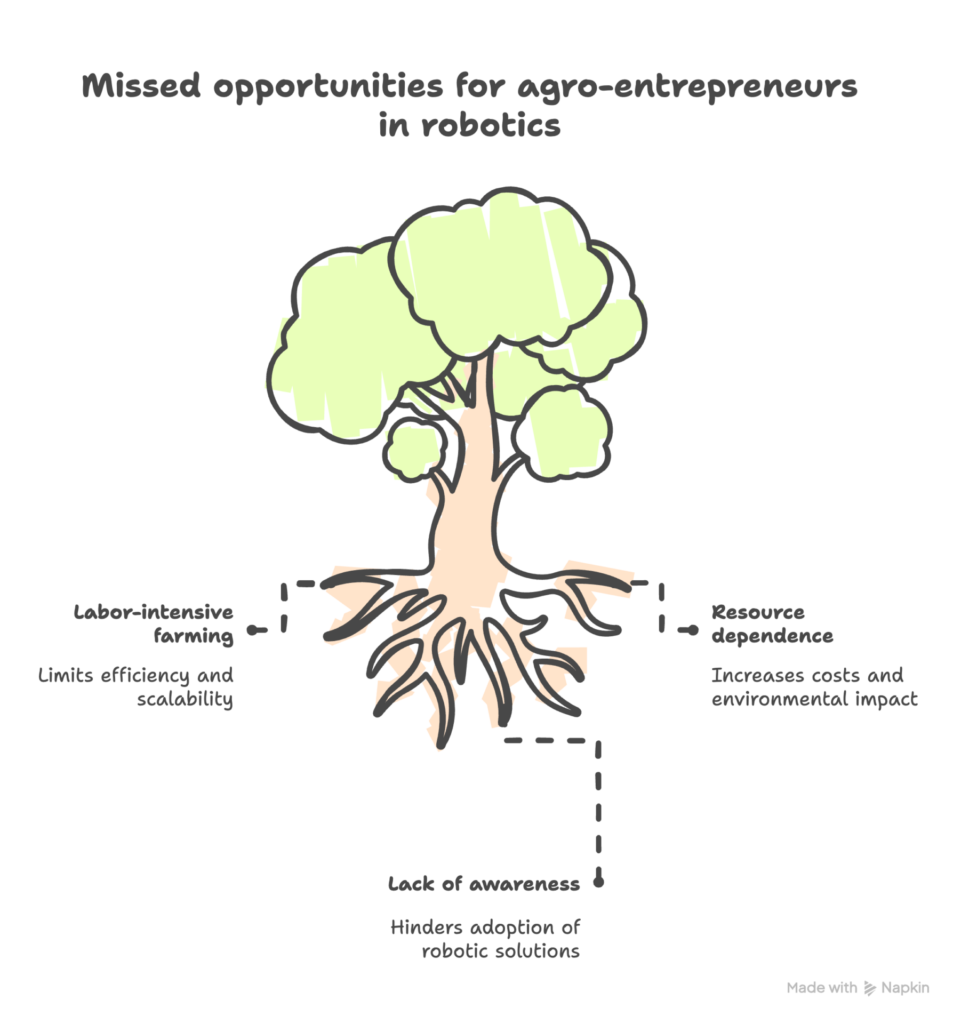Robotics Meets Roots: Automation Opportunities for New Agro-Entrepreneurs in 2026
The agricultural landscape is undergoing a silent revolution. While traditional farming remains labor-intensive and resource-dependent, agricultural robotics is transforming how food is grown, harvested, and managed. For new agro-entrepreneurs in 2026, this technological shift presents unprecedented opportunities—not just for large-scale operations, but for innovative beginners willing to embrace automation.
The agricultural robotics market is experiencing explosive growth, projected to reach USD 51 billion by 2029 from USD 16.6 billion in 2024, representing a compound annual growth rate of 25.2%. This isn’t just a trend—it’s a fundamental restructuring of agricultural production systems. The convergence of artificial intelligence, autonomous systems, affordable sensor technology, and data analytics has democratized access to robotics solutions that were previously the domain of large corporate farms.
For aspiring agro-entrepreneurs, understanding this landscape is critical. The question isn’t whether robotics will define the future of farming—it’s whether you’ll be positioned to lead it.

Why Agricultural Robotics Matters Now – Agricultural Robotics
Modern agriculture faces a perfect storm of challenges. Global labor shortages in farming are intensifying—particularly in developed nations where traditional agricultural workers are aging out of the profession. Simultaneously, environmental concerns demand sustainable practices that minimize chemical inputs and water waste. Rising operational costs squeeze already-thin farm margins, and climate unpredictability necessitates precision management of every resource.
Robotics addresses these challenges head-on. By 2026, over 60% of new agricultural equipment is projected to feature autonomous or AI-powered technology, fundamentally transforming how farms operate.
The beauty of robotics for new entrepreneurs is this: you don’t need massive acreage or deep capital reserves to start. The barriers to entry are lowering as costs decline and business models evolve. Companies are shifting from outright purchase models to leasing arrangements, robot-as-a-service (RaaS) options, and cooperative ownership structures that make automation accessible to smaller operations.
Key Automation Opportunities for Agro-Entrepreneurs in 2026
1. Precision Weeding Robotics – Agricultural Robotics
Weeding remains one of agriculture’s most labor-intensive and expensive tasks. Traditional approaches rely on manual labor or broad-spectrum herbicides—both unsustainable and economically problematic. Enter robotic weeding systems.
Laser weeding robots and AI-powered mechanical weeding solutions can reduce herbicide use by up to 80%. Companies like TartanSense are developing small rovers equipped with downward-facing cameras and computer vision systems that identify individual weeds and target them with precision sprayers or mechanical removal. This isn’t theoretical—these systems are already operational in India, designed specifically for smallholder farmers with landholdings of just a couple of hectares.
The ROI is compelling: Laser weeding systems can pay for themselves within one to two growing seasons in labor-intensive regions. For a beginner agro-entrepreneur starting with specialty crops or organic farming, weeding robots present an immediate value proposition. Initial investment starts around $25,000-$50,000 for scalable solutions, and the unit economics work: reduced labor costs, eliminated herbicide expenses, and the valuable bonus of field data collection for future optimization.
Real-world opportunity: Partner with local organic farmers as early adopters, offering weeding-as-a-service contracts. Your robot operates on their fields under your management, generating revenue while they avoid labor recruitment headaches. As operations scale, diversify into neighboring farms or expand the service to additional crops.
2. Targeted Pesticide Application Systems – Agricultural Robotics
Chemical application remains a major cost driver in conventional farming. Broad-spectrum spraying wastes pesticides, contaminates soil and water, and poses health risks to workers. Precision application systems change this equation.
AI-powered drones and ground-based robots equipped with targeted sprayers can reduce chemical use by up to 90% while saving $25-$30 per acre. The payback period is remarkably fast—typically 12-18 months on mid-sized farms.
For new entrepreneurs, this opportunity manifests in multiple business models. You could offer contract spraying services using precision drones or ground robots, positioning yourself as a precision application specialist. Alternatively, become an authorized retailer and service provider for precision spraying technology. Farmers increasingly understand that targeted chemical application is both environmentally responsible and economically smart—your role is facilitating that transition.
Emerging companies like Orbiba Robotics are specifically designing affordable, AI-powered platforms for organic agriculture, proving that cost-effective precision application is achievable for budget-conscious beginners.
3. Autonomous Harvesting Solutions – Agricultural Robotics
Harvesting is simultaneously mechanizable and highly specialized—different crops require different approaches. Robotic harvesting systems address labor shortages while improving harvest timing and reducing crop loss.
Robotic harvesters can reduce seasonal labor costs by up to 50% while operating 24/7, even at night under artificial lighting. California strawberry growers are already realizing “early success” with robotic picking systems, demonstrating commercial viability.
For agro-entrepreneurs, the harvesting opportunity is nuanced. Direct investment in harvesting robots requires specialization and typically serves specific crop types (strawberries, leafy greens, tree fruits). However, several viable entry points exist:
- Aggregator model: Develop a network of harvesting robots available for contract deployment during peak seasons. Farmers pay per-hour or per-ton rates, minimizing their capital outlay while you generate consistent revenue.
- Franchise approach: Partner with technology providers to operate their harvesting equipment in your region, building regional expertise and customer relationships that eventually support your own innovation.
- Specialty crop focus: Target high-value crops (berries, tree fruits, specialty vegetables) where labor costs are highest and farmers most willing to invest in solutions.
4. Data-Driven Irrigation Automation – Agricultural Robotics
Water scarcity and inefficient irrigation represent massive challenges across agricultural regions. Automated irrigation systems that respond in real-time to soil moisture, weather patterns, and plant requirements deliver both environmental and economic benefits.
Precision irrigation systems can reduce water waste significantly while maintaining or improving yields. IoT sensors embedded in fields collect soil moisture and nutrient data, feeding algorithms that optimize water delivery. Companies like Avanijal Agri Automation are proving this model in India—farmers control systems through simple apps, eliminating guesswork from irrigation management.
For beginners, the irrigation automation opportunity offers several advantages:
- Lower technology barrier: Implementing IoT sensors and automated controllers requires less robotics expertise than other applications. Any tech-savvy entrepreneur can learn system installation and programming.
- Scalability: One technician can manage systems across multiple farms, creating efficient unit economics.
- Recurring revenue: Subscription models for system maintenance, software updates, and data analytics support create predictable recurring income.
- Government support: Many regions offer subsidies and grants for water-efficient irrigation, reducing farmer reluctance and improving your sales economics.
Real-world pathway: Start by offering irrigation audits—identify farmers losing water to inefficient practices. Present automation solutions with clear ROI calculations. Begin with leasing models to minimize farmer risk, transition to ownership once they’ve experienced the benefits.
5. Drone-Based Scouting and Monitoring – Agricultural Robotics
Drones have become mainstream agricultural tools, but they require expertise to deploy effectively. Farmers need drone data translated into actionable insights—this is where new entrepreneurs create value.
Agricultural drones with multispectral sensors can save $10-$15 per acre in scouting costs while enabling early detection of stress, disease, or pest infestations. The real value, however, comes from interpreting drone imagery and converting it into decision-ready information.
This opportunity is particularly attractive for beginners because:
- Lower barrier to entry: Commercial drones cost $3,000-$15,000 with reasonable payback periods.
- Scalable service model: One drone operator can serve dozens of farms across a season, creating strong unit economics.
- Data insight opportunity: Partner with AI companies providing image analysis services. Your role becomes field data collection and farmer consultation—not complex algorithm development.
- Cross-selling potential: Drone data naturally leads to discussions about precision irrigation, targeted inputs, and automation systems—creating multiple revenue streams.
Market positioning: Become the “farm intelligence specialist” in your region. Offer regular scouting services, stress detection alerts, and input recommendations based on drone-derived data. Build reputation as someone who helps farmers make smarter decisions, not just someone flying drones overhead.
6. Robotics-as-a-Service (RaaS) Models – Agricultural Robotics
Perhaps the most exciting opportunity for new entrepreneurs is building RaaS businesses that lower farmer adoption barriers while creating predictable revenue streams.
Rather than selling robots outright (expensive for farmers, risky for vendors), RaaS models deploy equipment under service contracts. Farmers pay based on acreage served, hours used, or outcomes achieved. This completely changes the financial picture for both parties.
Consider this example: A farmer doesn’t want to invest Rs. 25 lakhs in a weeding robot. But if you offer to weed their 2-hectare field for Rs. 2,000 per season using your robot, the decision becomes trivial. Your robot works across ten farms throughout the season, generating Rs. 20,000 in revenue against modest depreciation and operating costs.
RaaS also creates authentic differentiation for new entrepreneurs. You’re not competing on robot manufacturing quality (where Deere and other incumbents dominate). You’re competing on understanding local farming systems, building trust with farmers, responsive service delivery, and operational excellence.
Viable RaaS business opportunities include:
- Seasonal service agreements: Deploy equipment during peak-demand periods (harvest, pesticide application, weeding).
- Maintenance contracts: Charge monthly fees for equipment maintenance, ensuring farmers’ systems run optimally.
- Data subscription services: Charge ongoing fees for analytics, advisory services, and performance optimization based on robot-collected data.
- Cooperative models: Partner with farmer cooperatives, offering shared equipment that members access on rotational schedules.
The Path Forward: Building Your Agro-Robotics Business in 2026 – Agricultural Robotics
Understanding opportunities is foundational. Execution determines success.
Start with Specialist Focus – Agricultural Robotics
Begin with one well-defined problem in your geographic area. Don’t attempt to become a generalist robotics provider. Specialist positioning builds credibility, simplifies operations, and creates defensible market position.
Consider your strengths: Do you have relationships with specific crop communities? Deep knowledge of particular farming challenges? Access to specific farmer groups? Lead with these advantages.
Prioritize Adoption Barriers Beyond Cost – Agricultural Robotics
Yes, affordability remains a restraint—robotics solutions are expensive, and cash-stripped farmers operate with razor-thin margins. But cost isn’t the only barrier. Equally important are:
- Trust: Farmers need confidence you understand their operations and won’t leave them stranded.
- Simplicity: Technology must integrate into existing workflows without requiring operator retraining.
- Proven economics: Farmers want case studies, data, and clear ROI calculations—not promises.
- Local support: Responsive service and local expertise matter more than sophisticated global supply chains.
Address these barriers deliberately in your business model.
Leverage Government Programs – Agricultural Robotics
Most agricultural regions offer subsidies, grants, and favorable financing programs for agricultural technology adoption. Understanding and leveraging these programs can substantially improve farmer economics and accelerate your sales cycles. Become the expert who helps farmers access available support.
Build Data Capabilities – Agricultural Robotics
Increasingly, robot-generated data becomes the most valuable asset. Sensor systems, imagery, operational logs—these create insights that drive better decisions. Develop capabilities to analyze and present this data compellingly.
This positions you not just as an equipment provider but as a data insights partner. Data monetization becomes a revenue stream while building switching costs and customer stickiness.
Start Small, Prove Economics, Scale Deliberately – Agricultural Robotics
Resist the urge to overextend. Begin with one robot, one crop, one geographic area. Prove the business model works. Document everything—financial performance, farmer testimonials, operational learnings. Use this as your platform for scaling.
The best agro-entrepreneurs in 2026 won’t be those who invested Rs. 1 crore in robots before understanding their market. They’ll be those who started scrappy, proved concepts, and scaled systematically.
The 2026 Opportunity Window – Agricultural Robotics
Agricultural robotics adoption is inflecting. The technology works, costs are declining, and business models enabling access are emerging. Yet market penetration remains early—creating a genuine first-mover advantage for focused entrepreneurs.
Labor shortages persist. Environmental pressures intensify. Farmer economics demand efficiency. These aren’t temporary trends. They’re structural shifts that make agricultural robotics not an optional advantage but increasingly necessary for farm viability.
The window to establish yourself as a credible automation provider in your region is now. By 2026, the opportunity will still exist, but the competitive landscape will be far more crowded. Early movers will have built farmer relationships, proven track records, and established operations that are difficult for later entrants to displace.
For new agro-entrepreneurs ready to blend technology, agriculture, and business innovation, robotics represents more than an opportunity. It represents the future of farming itself—and a chance to shape how that future unfolds in your community.
The soil remains the foundation. But roots increasingly intertwine with robotics, data, and smart automation. Entrepreneurs who understand both will thrive.







One Comment